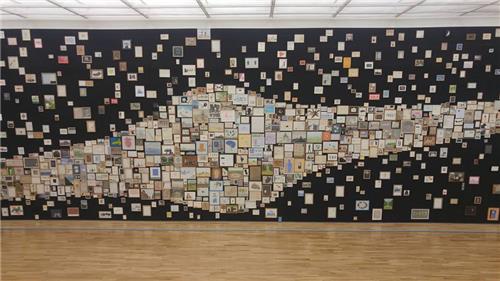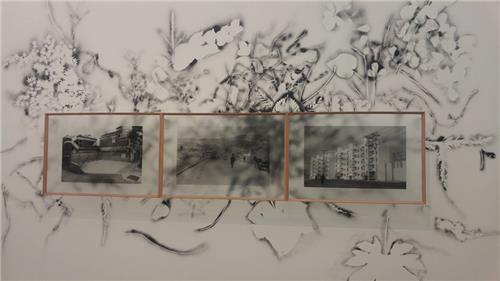- California Assembly OKs highest minimum wage in nation
- S. Korea unveils first graphic cigarette warnings
- US joins with South Korea, Japan in bid to deter North Korea
- LPGA golfer Chun In-gee finally back in action
- S. Korea won’t be top seed in final World Cup qualification round
- US men’s soccer misses 2nd straight Olympics
- US back on track in qualifying with 4-0 win over Guatemala
- High-intensity workout injuries spawn cottage industry
- CDC expands range of Zika mosquitoes into parts of Northeast
- Who knew? ‘The Walking Dead’ is helping families connect
National art museum to exhibit artworks by Korea Artist Prize finalists
SEOUL, Aug. 30 (Yonhap) — The Museum of Modern and Contemporary Art (MMCA) will open an art show on Wednesday to showcase the artwork by four finalists of an annual artist prize, the museum said Tuesday.
The MMCA has given the award, the Korea Artist Prize, to the country’s leading contemporary artists since 2012, jointly with the SBS Culture Foundation, and been holding an accompanying exhibition to support and introduce “the most capable and creative artists in Korea.” This continues the tradition of the “Artist of the Year” that took place from 1995-2000.
“Since the Seoul branch of the MMCA opened in 2013, cooperation with businesses has increased,” Kang Seung-wan, a curator at the museum told reporters in a press briefing Tuesday. “We hope to do the artist sponsoring project long term to introduce more Korean artists worldwide.”
The museum and the SBS sponsor overseas exhibitions for the finalists and the winner will get additional sponsorship.
This year’s finalists include three individual artists, Kim Eull, Back Seung-woo, and Ham Kyung-ah, and one team, Mixrice (Yang Chul-mo, Cho Ji-eun). All have shown outstanding, unique creations through various artistic media, from photography to drawings to installation works.
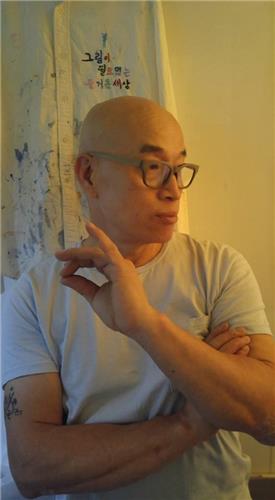
Kim Eull talks with reporters during a press meeting for the Korea Artist Prize 2016 by the Museum of Modern and Contemporary Art (MMCA) at the MMCA’s Seoul branch on Aug. 30, 2016.
In Gallery 1, jewelry designer-turned-artist Kim Eull exhibits “Galaxy,” a massive cluster of 1,450 drawings on the 27.5-meter-long exhibition wall, which the artist said was the result of his existence and thoughts colliding with that of the outer world.
“I’ve been making drawings for nearly 20 years. It feels like I am in the middle of creating a huge self-portrait,” Kim said. “The exhibition is part of the on-going creation and countless splinters of my thoughts are being expressed in them.”
In the corner of the hall, Twilight Zone Studio, a two-story life-size replica of his own studio, has been built where gallery-goers can explore to see what the artist’s work space looks like. Through a window on the second floor, visitors can view “Galaxy” as if seeing the twinkling stars in the sky.
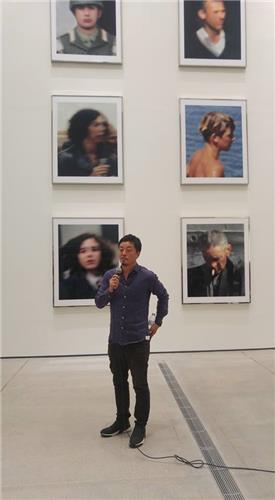
Back Seung-woo talks about his work “Betweenless,” hung on the wall behind him at the Seoul branch of the Museum of Modern and Contemporary Art (MMCA) during a press meeting for the Korea Artist Prize 2016 by the MMCA on Aug. 30, 2016.
In Gallery 2, works by the rest of the artists are on display.
Back Seung-woo called himself a “picture-grapher” not a photographer in defiance of what the artist described as the inundation of digital images. In the age of excessive images floating around the online world, he started questioning the meaning of taking photos. He said he came to the conclusion that it was a meaningless act as if “firing a water gun underwater.”
Through his four works on display, he shows various attempts to redefine the meaning of photography and contemplate its future, by editing, distorting, rearranging, erasing context and adding new meanings. Only one work shows the photos that he took himself, while the rest were created based on an archive of photos that he bought.
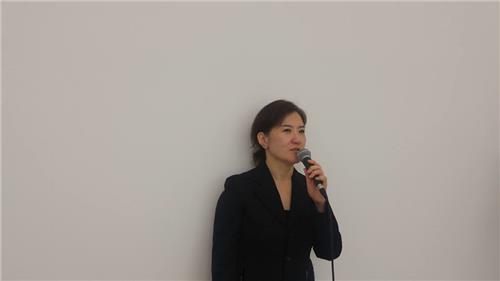
Ham Kyung-ah explains her work during a press meeting for the Korea Artist Prize 2016 by the Museum of Modern and Contemporary Art (MMCA) at the MMCA’s Seoul branch on Aug. 30, 2016.
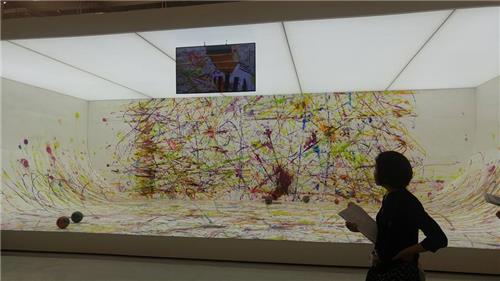
An art project by Ham Kyung-ah with a young North Korean defector who dreams of becoming a soccer player for the Korean national team.
Further down the exhibition hall, the works by installation and conceptual artist Ham Kyung-ah are being shown.
Having challenged social injustice and taboo in various artistic endeavors, in ths piece she talked about the plight and perilous journey of North Korean refugees. A miniature soccer field is decorated with the colorful traces made when a young North Korean boy, who dreams of becoming a popular soccer player, kicked a ball smeared with paint in random directions.
Lastly, the only team, Mixrice, made of Cho Ji-eun and Yang Chul-mo, takes on yet another challenge Korean society faces: immigration, uprooting and the settlement of humans and, interestingly enough, plants.
In previous projects, they’ve persistently tackled various circumstances where uprooting is believed to forfeit something significant such as accumulated time, and documented the process via multi-channeled devices – photography, videos, cartoons, murals and festivals. For this exhibition, they shed extra light on the fate of old trees that were relocated to create, ironically, nature for city dwellers.
The winner will be chosen in October based on the results of the exhibition, the museum said. The show will run through Jan. 15, 2017.
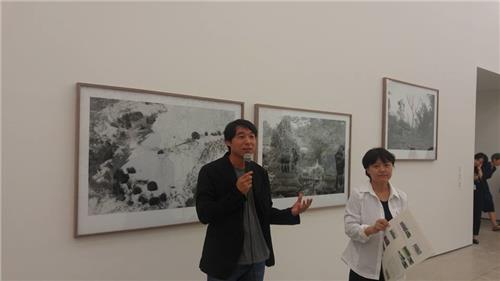
Mixrice answers questions from reporters during a press meeting for the Korea Artist Prize 2016 by the Museum of Modern and Contemporary Art (MMCA) at the MMCA’s Seoul branch on Aug. 30, 2016.







